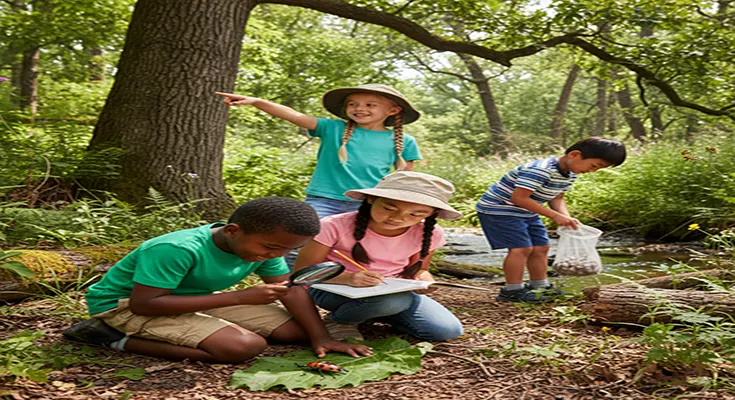In a world increasingly dominated by screens, the greatest classroom for children remains the great outdoors. Engaging in outdoor activities for kids is not just about fun and fresh air; it’s a powerful and practical way to ignite a lifelong passion for nature and ecology. By stepping outside, children can transform abstract concepts into tangible, exciting discoveries.
Here are several hands-on, educational outdoor activities that turn every backyard, park, or trail into a living, breathing laboratory.
1. The Nature Scavenger Hunt: Sharpening Observation Skills
A scavenger hunt is one of the simplest yet most effective ways to encourage active observation. Instead of just listing common objects, focus the hunt on ecological themes:
- Colors & Textures Hunt: Challenge kids to find items that are smooth, rough, bumpy, vibrant red, or dull green.This teaches them to distinguish between living and non-living elements and to appreciate the diversity of natural materials.
- Decomposition Detectives: Ask them to find a leaf that is freshly fallen, partially eaten by an insect, and mostly decomposed. This is a perfect introduction to the concept of life cycles and the role of decomposers in an ecosystem.
- The Biotic & Abiotic Hunt: Create two columns: Biotic (living or once-living) and Abiotic (non-living). Items could include a feather, a piece of bark, a rock, a puddle, and a blade of grass. This helps them understand the fundamental components of any ecosystem.
2. Building a Critter Hotel: Habitat and Shelter
Learning about animal habitats can be brought to life by actually constructing one. A simple “Bug Hotel” or “Critter Condo” teaches children about the fundamental needs of living things—food, water, and shelter.
- How to Build It: Gather natural and recycled materials like hollow bamboo shoots, old wooden pallets, pinecones, straw, and small logs. Stack and arrange them to create tiny crevices and compartments.
- The Ecology Lesson: Discuss which small creatures (spiders, solitary bees, woodlice) might use each material for shelter. This fosters empathy for small wildlife and teaches how different animals adapt to their environments. Observing who moves in over time becomes a rewarding, long-term ecology project.
3. DIY Bird Feeders and Birdwatching: Food Chains in Action
Birdwatching is a peaceful activity that hones patience and observation. Creating a feeder adds a direct, hands-on lesson about wildlife support.
- Make the Feeder: Use simple materials like pinecones coated in peanut butter and birdseed, or recycled plastic bottles cut into feeders.
- The Ecology Lesson: Set up a quiet “sit spot” near the feeder. Use a simple field guide to identify visitors. Log the types of birds and the foods they eat. This introduces children to ornithology (the study of birds) and the concept of food webs, illustrating how plants (seeds) support birds, which in turn may become prey for other animals.
4. Soil Erosion Experiment: Environmental Stewardship
Demonstrating the impact of rain on different types of ground cover makes a great outdoor science experiment and introduces the concept of soil conservation.
- The Setup: Use three disposable aluminum pans filled with soil.
- Leave the first pan bare soil.
- Cover the second pan with a layer of grass or leaves (natural ground cover).
- Cover the third pan with small rocks or pebbles (to mimic a rocky area).
- The Experiment: Prop the pans up on one end and pour the same amount of water (simulating rain) over each one. Collect the runoff in separate jars.
- The Ecology Lesson: Compare the water in the three jars. The jar from the bare soil will likely have the muddiest water, showing the most erosion. Discuss how plant roots hold soil in place and why ground cover is vital for preventing erosion and keeping waterways clean.
5. Nature Journaling: Documenting the Living World
Nature journaling is the perfect activity to conclude an outdoor adventure, transforming observations into a personalized learning record.
- What to Include: Encourage children to draw what they saw (a specific leaf shape, a funny-looking insect), write down their observations (the smell of the air, the sound of the wind), and even press small, fallen treasures like flowers or leaves.
- The Ecology Lesson: Over time, a nature journal becomes a record of the seasons and local biodiversity. It strengthens the child’s connection to their local environment, encouraging a deeper sense of care and stewardship for the living world they are documenting.
By integrating these fun, hands-on activities into outdoor playtime, parents and educators can cultivate not just a child’s knowledge of facts, but a profound and lasting love for nature and a sense of responsibility for the delicate balance of our planet’s ecology. The world is a vast, open book—all we have to do is encourage kids to start turning the pages.











